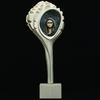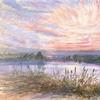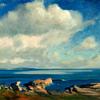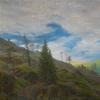Amon Carter Museum Acquires Rediscovered Painting from Indian Series by George de Forest Brush
- FORT WORTH, Texas
- /
- January 25, 2010

The Amon Carter Museum has acquired a rediscovered painting by American artist George de Forest Brush. The Potter, painted in 1889, had been in private hands since 1946, when it was sold from the collection of the Galveston financier William L. Moody III.
“The acquisition of one of Brush’s ‘lost’ Indian pictures is a major addition to our collection of material relating to the American West,” says Dr. Ron Tyler, director of the Amon Carter Museum. “Now, our visitors will have the opportunity to view Brush’s exacting but highly nuanced depiction of an Indian within the context of other representations of indigenous people, such as those presented by painters George Catlin and Frederic Remington and photographer Edward S. Curtis, whose entire multivolume portfolio, The North American Indian, was also recently acquired by the museum.”
The Carter’s newly acquired painting is among the final works in Brush’s Indian series and exemplifies the artist’s rigorous academic training. Exceedingly spare, the painting depicts a single, isolated figure within an indeterminate darkened interior. Unlike earlier works in the series, which center on themes of conflict, native customs or engagement with the natural world, The Potter portrays the seated figure of a native artisan intently focused on the task of glazing a hand-crafted vessel. The meticulous precision with which Brush drew and painted the human body is matched by his pictorial mastery of color and texture in the few carefully placed decorative elements within the composition.
“Brush’s academic training was grounded in the French tradition, which focused on the idealized human body and prized paintings with allusions to classical art,” says Dr. Rick Stewart, the Carter’s senior curator of western painting and sculpture. “By using the Indian theme, Brush could apply his technical expertise and extensive knowledge of ancient art and Old Master painting to a thoroughly American subject with its own tradition of pictorial representation.”
Brush began the series of paintings of Indian subjects in 1882, while living first in Wyoming at Fort Washakie and later in Montana at the Crow Agency, sketching members of the Arapahoe, Shoshone and Crow peoples. He continued to work on the series throughout the 1880s, traveling widely to study native cultures in eastern Canada and Mexico and along coastal northeastern Florida. Along the way he assembled a collection of indigenous artifacts for use as studio props. The Indian paintings, though initially based on the artist’s firsthand experiences among native people, have little basis in the reality of contemporary American Indian life.
“One of the more intriguing aspects of the Indian paintings is that, despite the high degree of realism Brush brought to these pictures, he was not concerned with a cogent narrative or with historical or ethnographic accuracy,” says Stewart. “Regardless, and interestingly also because of this, the paintings brought the artist both critical and commercial success.”
The Indian pictures evolved from compositions with multi-figured narratives set within the landscape to compositions that feature a solitary individual engaged in the manual creation of art, as seen in The Potter. The paintings present a carefully calibrated, fictitious, pre-industrial world where idealized Indians lived in a timeless environment undisturbed by the advent of modernism. For Brush, the Indian became a metaphor, a way to express personal concerns, including his skepticism over industrialization and the mechanization of labor. Ultimately, Brush conceived the Indian series as a progressive meditation on the theme of human creativity.
“It’s always thrilling when notable works of art resurface in pristine condition and are able to be shared with the public,” says Tyler, who also notes that The Potter was exhibited in 1889 at the National Academy of Design, along with Frederic Remington’s Dash for the Timber, one of Amon G. Carter’s most important acquisitions.
The Potter is on view in the museum’s upstairs painting and sculpture galleries beginning January 29, 2010.
About George de Forest Brush
Born in Shelbyville, Tenn., in 1854 or 1855, George de Forest Brush was raised in Danbury, Conn. After studying art in New York City at the National Academy of Design from 1870 to 1873, Brush continued his education in Paris, enrolling in classes at the highly competitive École des Beaux-Arts. There, his skills in depicting the human figure were measured against an international cadre of young art students. He also gained admittance, as Thomas Eakins had before him, into the atelier of Jean-Léon Gérôme, one of the school’s foremost teachers. Brush taught at The Cooper Union and at The Art Students League, and he exhibited and was a member of the National Academy of Design. After completing his series of paintings of Indians, Brush turned to the theme of the “mother and child” for which he is best known. He was elected to the Society of American Artists, National Academy of Design, and the American Academy of Arts and Letters. Brush died in Hanover, N.H. in 1941.
-end-
Tracy Greene
Public Information Officer
Amon Carter Museum
3501 Camp Bowie Blvd., Fort Worth, TX 76107
t. 817.989.5067 f. 817.665.4324
Connect to the American experience through great works of art.
3501 Camp Bowie Blvd.
Fort Worth, Texas
817.738.1933
http://www.cartermuseum.org/
About Amon Carter Museum
Amon G. Carter, a legendary figure in Texas history, was for most of his life Fort Worth’s leading citizen and champion. Mr. Carter’s will provided for the establishment of a museum in Fort Worth devoted to American art. “As a youth, I was denied the advantages which go with the possession of money,” he stated in the will. “I am endeavoring to give to those who have not had such advantages, but who aspire to the higher and finer attributes of life, those opportunities which were denied to me.” Our Mission The Amon Carter Museum was established through the generosity of Amon G. Carter Sr. (1879–1955) to house his collection of paintings and sculpture by Frederic Remington and Charles M. Russell; to collect, preserve, and exhibit the finest examples of American art; and to serve an educational role through exhibitions, publications, and programs devoted to the study of American art.













100x100_c.jpg)


